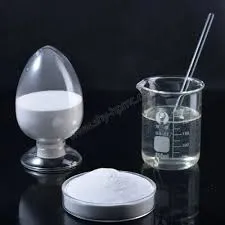
Nov . 07, 2024 14:55 Back to list
Exploring the Glass Transition Temperature of HPMC in Polymer Applications
Understanding the Glass Transition Temperature in HPMC
Hydroxypropyl methylcellulose (HPMC) is a versatile cellulose derivative widely used in various industries, including pharmaceuticals, food, and construction. One of the most critical properties of HPMC that significantly affects its application is its glass transition temperature (Tg). Understanding the glass transition temperature of HPMC is essential for optimizing its performance in different formulations and processes.
What is Glass Transition Temperature (Tg)?
The glass transition temperature is the temperature range at which a polymer transitions from a hard and glassy state to a more rubbery and flexible state. Below Tg, the molecular motions are significantly restricted, giving the polymer its rigidity. As the temperature rises above Tg, increased molecular mobility leads to a more flexible structure. This transition is crucial for many applications, as it influences the polymer's physical properties, such as mechanical strength, solubility, and stability.
Importance of Glass Transition Temperature in HPMC
For HPMC, Tg plays a significant role in determining its stability and performance in various formulations. For instance, in pharmaceutical applications, the glass transition temperature affects the release profile of drug formulations. When HPMC is used as a matrix for controlled drug release, its Tg can dictate the rate at which the drug is released from the matrix, impacting its effectiveness.
In food applications, the Tg of HPMC influences its texture, stability, and shelf life. For example, in food coatings and emulsions, a suitable Tg ensures that the coating maintains its structure under different temperature conditions, enhancing its ability to protect the food product.
Moreover, in construction, the presence of HPMC in mortars and other compounds provides essential properties like workability and water retention. The Tg helps ensure that these materials perform effectively under varying environmental conditions, affecting their durability and application performance.
Factors Affecting Tg in HPMC
hpmc glass transition temperature

Several factors influence the glass transition temperature of HPMC
1. Molecular Weight Higher molecular weight HPMC generally exhibits a higher Tg. This is due to the increased entanglement of polymer chains, which restricts molecular mobility, resulting in a higher energy requirement for the transition to the rubbery state.
2. Degree of Substitution The degree of hydroxypropyl and methyl substitution on the cellulose backbone also affects Tg. Different substitution patterns result in variations in intermolecular interactions, thus altering the Tg.
3. Moisture Content The presence of moisture can significantly lower the Tg of HPMC. Water molecules can act as plasticizers, disrupting the intermolecular interactions between polymer chains, thus allowing them to move more freely at lower temperatures.
4. Additives The incorporation of plasticizers, fillers, or other additives can also affect Tg. Plasticizers tend to lower Tg, while certain fillers may increase it depending on their nature and interaction with the HPMC matrix.
Applications and Implications
Understanding and controlling the glass transition temperature of HPMC is crucial for formulators. By manipulating factors such as molecular weight and degree of substitution, formulators can optimize HPMC for specific applications, ensuring that the material performs effectively under expected temperature conditions.
In pharmaceutical contexts, achieving a specific Tg can enhance the performance of drug delivery systems, leading to better therapeutic outcomes. Similarly, in food science, controlling Tg allows for the development of products with desired textural properties and shelf stability.
In conclusion, the glass transition temperature is a vital characteristic of HPMC that has significant implications across various fields. By understanding the factors that influence Tg, industries can better harness the properties of HPMC, leading to innovations and improvements in product performance. As research progresses, further elucidation of Tg and its relationship with HPMC will continue to enhance its applications in both existing and emerging technologies.
-
Versatile Hpmc Uses in Different Industries
NewsJun.19,2025
-
Redispersible Powder's Role in Enhancing Durability of Construction Products
NewsJun.19,2025
-
Hydroxyethyl Cellulose Applications Driving Green Industrial Processes
NewsJun.19,2025
-
Exploring Different Redispersible Polymer Powder
NewsJun.19,2025
-
Choosing the Right Mortar Bonding Agent
NewsJun.19,2025
-
Applications and Significance of China Hpmc in Modern Industries
NewsJun.19,2025







